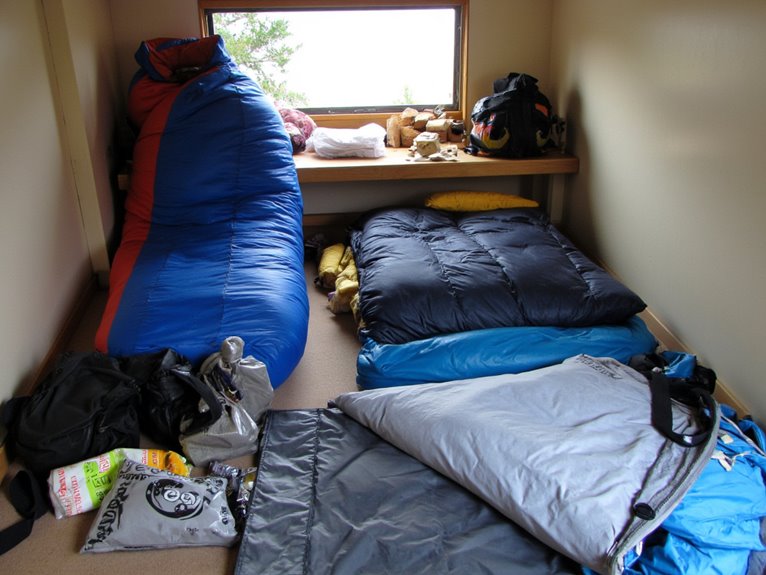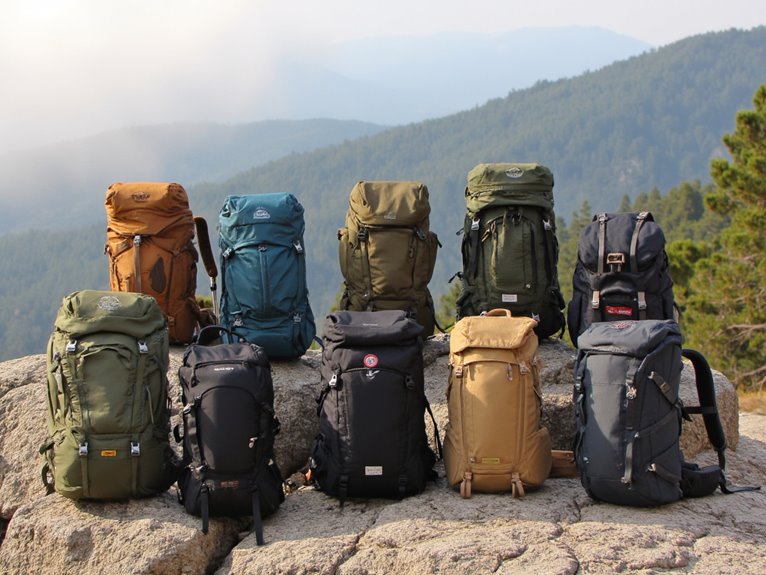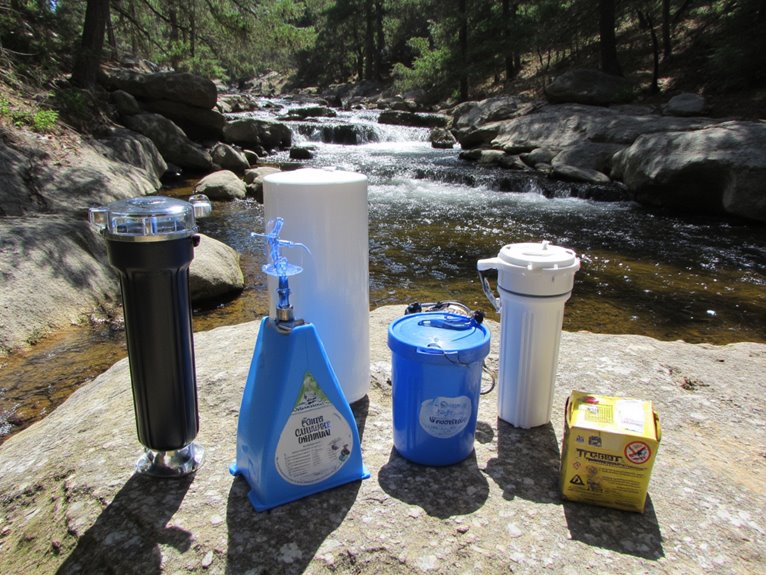Packing & Storing Your Sleeping Gear: Best Practices for Longevity
Clean your sleeping gear after each use with manufacturer-recommended products, avoiding standard detergents that damage technical fabrics. Dry items thoroughly in well-ventilated areas below 60% humidity, hanging sleeping bags vertically to prevent mold growth. Store gear uncompressed in breathable cotton bags within climate-controlled environments between 50-70°F. Use airtight containers with silica gel packets to combat moisture and pests. Conduct monthly inspections during active seasons, documenting maintenance schedules to identify wear patterns before they compromise performance.
We are supported by our audience. When you purchase through links on our site, we may earn an affiliate commission, at no extra cost for you. Learn more. Last update on 10th December 2025 / Images from Amazon Product Advertising API.
Notable Insights
- Store sleeping bags in breathable cotton storage sacks rather than compression sacks to maintain insulation loft and fabric integrity.
- Ensure gear is completely dry before storage by hanging vertically in well-ventilated areas with humidity below 60%.
- Use climate-controlled environments between 50-70°F and place silica gel packets nearby to prevent moisture damage and mold growth.
- Clean sleeping gear after each use with specialized products to remove oils and food particles that attract pests.
- Conduct monthly inspections during active seasons and maintain maintenance logs to track cleaning schedules and identify wear patterns.
Proper Cleaning Techniques for Maximum Gear Lifespan
Longevity defines the difference between gear that lasts decades and equipment that fails after a few seasons.
Your cleaning approach directly impacts how gear materials perform over time. Use specialized cleaning products designed for technical fabrics—standard detergents contain harsh chemicals that break down waterproof coatings and insulation fibers.
Standard detergents destroy technical fabrics—specialized cleaners preserve waterproof coatings and insulation fibers that keep your gear performing season after season.
Follow manufacturer-specific washing techniques religiously. Machine wash sleeping bags in front-loading washers on gentle cycles to prevent zipper damage. Hand washing works better for down-filled items requiring delicate care.
Clean gear after each use to prevent bacterial growth and material degradation.
Inspect equipment before cleaning. Repair tears with patches and silicone glue first. Use soft brushes for debris removal on boots and packs.
Check zippers and buckles post-cleaning to guarantee functionality remains intact. Keep water temperature below 40°C when washing technical gear to prevent fabric damage and preserve material integrity.
Thorough Drying Methods to Prevent Mold and Mildew
After cleaning your sleeping gear, immediate and thorough drying becomes the critical barrier between functional equipment and mold-damaged investment losses. Unpack all items immediately after trips to maximize air exposure.
Hang sleeping bags and tents vertically to increase surface area contact with circulating air.
Effective drying techniques require environmental control. Maintain ambient humidity below 60% using hygrometers for accurate monitoring.
Position gear in well-ventilated areas with indirect sunlight or fan-assisted airflow. Avoid basements and garages unless you’re using dehumidifiers.
For moisture control, shake items periodically to redistribute trapped water and check seams for dampness. Down-filled gear needs frequent fluffing during the 24-hour drying cycle.
For sleeping pads specifically, inflate while drying and periodically check for any trapped moisture inside the pad structure.
Never pack damp equipment, even temporarily. Use breathable storage materials and desiccant packets for long-term protection.
Storage Strategies That Preserve Insulation and Fabric Integrity
Three fundamental principles govern proper sleeping gear storage: environmental control, space management, and compression avoidance.
You’ll need climate-controlled locations with consistent temperatures and low humidity to maintain insulation loft. Avoid attics, basements, and garages where temperature fluctuations damage fabric integrity.
Storage container types greatly impact gear longevity. Choose 90L cotton storage bags for ideal breathability and protection. These containers allow air circulation while preventing dust accumulation.
Never use compression sacks for long-term storage—they permanently reduce insulation effectiveness.
Humidity control requires additional measures in challenging climates. Place silica gel packets near stored bags to absorb excess moisture.
Combat moisture damage with strategically placed silica gel packets positioned throughout your storage area to maintain optimal humidity levels.
For best results, hang sleeping bags on sturdy hangers or lay them flat on shelves. This prevents compression while maintaining proper loft distribution throughout the insulation layers.
Store your sleeping bag in oversized breathable sacks or hang it loosely in a cool, dry place away from direct sunlight to preserve its thermal performance.
Protecting Your Investment From Pests and Environmental Damage
While proper storage conditions protect your sleeping gear from environmental hazards, active pest prevention measures safeguard your investment remains functional for years.
- Clean sleeping bags and pads with mild soap, removing food particles and body oils that attract insects and rodents.
- Apply DEET or picaridin-based pest repellents to gear surfaces before storage in sealed containers.
- Store gear in airtight, rodent-proof containers away from basements and attics where moisture accumulates.
- Conduct monthly gear inspection sessions, checking for moth holes, rodent chew marks, and insect egg deposits.
- Position storage areas away from standing water sources and seal entry points larger than ¼-inch diameter.
Regular gear inspection prevents costly damage. Check zippers, fabric seams, and insulation chambers for pest activity.
Store sleeping systems in climate-controlled environments between 50-70°F with humidity below 50%.
For sleeping pads specifically, maintain storage temperatures between 32-75°F in dry, dark environments to prevent material degradation.
Maintenance Schedules and Inspection Protocols for Peak Performance
Beyond preventing pest damage and environmental deterioration, your sleeping gear requires systematic maintenance schedules to preserve peak performance throughout its operational lifespan.
Establish monthly inspection frequency during active seasons to identify wear patterns, fabric stress points, and insulation compression. Document findings in detailed maintenance logs that track cleaning dates, waterproofing applications, and repair history.
Pre-season protocols include thorough gear condition assessments and waterproofing treatments. Post-use inspections focus on moisture detection, stain identification, and structural integrity evaluation.
Annual deep cleaning schedules promote long-term fabric performance for infrequently used gear. Your maintenance logs serve as performance baselines, helping predict replacement timelines and warranty claims.
Regular inspection schedules prevent minor issues from escalating into costly replacements, extending gear lifespan notably. For sleeping pads, check specifically for small punctures and slow leaks during each inspection, as these common issues can be easily repaired when caught early.




